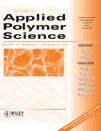Modeling of multifilament PET fiber melt-spinning
Abstract
A fundamental issue in the polymer fiber melt-spinning process is the control of final properties. Most available melt-spinning models simulate only a single fiber, providing an incomplete representation of the actual industrial multifilament process. Variations across the fiber bundle in cooling air velocity and temperature result in nonuniformity in fiber properties. Simulation can provide insight into this cause-and-effect relationship and lead to better process design to control differences between fibers. The few multifilament models in existence typically use a Newtonian constitutive model for the polymer, failing to capture nonlinear effects which often play a significant role in the process. Experimental validation of multifilament simulation is lacking. We present a nonisothermal multifilament spinning model, applicable for a variety of polymer and process conditions. The model combines the flow-enhanced crystallization (FEC) fiber spinning model of McHugh et al. with a generalization of Dutta's multifilament model. The model predicts fiber properties such as stress, degree of crystallinity, fiber radius and temperature as a function of distance from the spinneret, along with quench air cross velocity and temperature throughout the fiber bundle region. The McHugh FEC model for single fiber spinning, based on a modified Giesekus constitutive model and Avrami-type crystallization kinetics, has been experimentally validated. In this work we show that results of the multifilament quench air model compare favorably to experimental measurements. © 2008 Wiley Periodicals, Inc. J Appl Polym Sci, 2008




